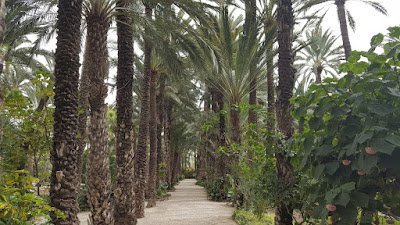 |
| Phoenix dactylifera |
Commonly known as the 'Date Palm', Phoenix dactylifera is an important commercial crop cultivated for its edible sweet fruit. The species name dactylifera is from the Greek - meaning 'date-bearing'. Incidentally it also means 'finger-bearing', presumably as a reference to the 'finger-shaped' seeds.
Phoenix dactylifera has been cultivated in the Middle East and the Indus Valley since ancient times. In fact there is archaeological evidence of date cultivation in eastern Arabia since 6000 BC! As such its origins are hard to place but Phoenix dactylifera is generally believed to native to the lands around Iraq.
 |
| Dates deglet from Biskra |
The mid-green, outward arching leaves can grow to between 4–6 metres long with approximately 150 leaflets. Each leaflets is roughly 30 cm long and 2 cm wide. Once mature, the crown can range from 6–10 metres in width.
Phoenix dactylifera is a dioecious species meaning that male and female flowers are produced on separate plants. Fossil records show that the Phoenix dactylifera date palm has existed for at least 50 million years and like a number of ancient plant species pollination is by both wind and insect. The inconspicuous blooms are yellowish-brown and about 1 cm wide. These are produced on large multibranched panicles 30–90 cm long. Once pollinated, the subsequent edible fruit (botanically called a drupe and commonly known as a date) are 1–7 cm long, turning yellow to red-brown or dark purple when mature. Inside each date there is one elongated, deeply grooved seed.
 |
| Phoenix dactylifera avenue Elche, Spain |
When grown in warmer climates, Phoenix dactylifera has proven to be a surprisingly resilient. It is not particular about soil type and will even grow in poor soils. It has a deep root system, essential for both supporting such a tall plant and for seeking out subterranean water sources. It will perform well in hot arid climates although it is less happy in these more tropical surroundings where it can drop its fruits before they have fully ripened. Water during periods of drought for the first couple of years until the roots have established. Once established Phoenix dactylifera will prove to be a particularly drought and wind tolerant species.
Main image credit - By No machine-readable author provided. MPF assumed (based on copyright claims). - No machine-readable source provided. Own work assumed (based on copyright claims)., CC BY 2.5, https://commons.wikimedia.org/w/index.php?curid=768173
Secondary image credit By M. Dhifallah - M. Dhifallah, CC BY-SA 3.0, https://commons.wikimedia.org/w/index.php?curid=5008481
Third image credit - me, Simon Eade
For related articles click onto the following links:
HOW TO GROW A DATE PALM FROM SEED?







No comments:
Post a Comment